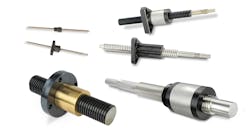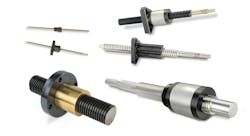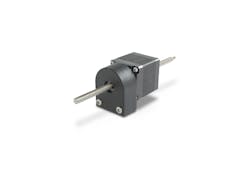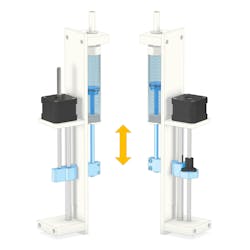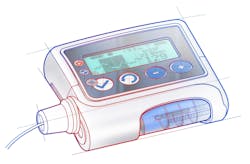Customizing Lead Screws for Performance, Compactness, Cost and Compliance
Lead screws are often called the workhorses of motion control. They consist of a threaded shaft and a nut that carries the load along the shaft or guides the shaft in moving the load, and they derive energy from an attached servo or stepper motor.
OEM designers have thousands of off-the-shelf lead screws and related components from which to choose, but every motion profile is different and achieving the perfect fit for any single application is often challenging. While experienced motion engineers and automated selection tools can get you close to an ideal solution, optimization will almost always require a degree of customization. Understanding the wide range of available options will help you determine the potential role and need for customization in your applications.
What can you Customize?
Customization must always begin with an appreciation of the end-user’s needs, which will eventually translate to specific design requirements and, ultimately, the motion solution. Lead screw shafts integrated with servo or stepper motors offer what may be the widest range of customization options. Following are the most common candidates for customization:
- Screw shafts, such as changing pitch or leads, length, stroke and end journaling.
- Nuts, such as carriage shape and size, flanges and press fitting.
- Materials, such as changing stainless steel bearings or aluminum or plastic housings; nuts or bushings made in a special metal, plastic, composite or ceramic materials.
- Surface treatments, such as paint quality or color and thickness of anodized aluminum parts.
- Mounting, such as orientation brackets, along with various couplings or angles.
- Connections, such as tooling.
- Keyways, such as flats to secure the screw to a motor or driven component; bore sizes.
- Integrations, such as hybrid systems combining screw, nut, gearing, rail support and stepper motor.
- New designs, such as adapting existing products for new functionality or designing a new product or system from scratch.
- Services, such as lubrication, stocking, transportation, training, repair and maintenance.
Why Customize?
Among the most common customization objectives are improving performance, optimizing space, extending durability, resisting environmental threats, complying with regulations and conversion from pneumatic cylinders.
Using configuration options and online tools will bring you close to an effective motion solution, but it usually takes a degree of customization to reach your desired performance, physical attributes, regulatory compliance and cost-saving objectives.
Customizing Performance
Custom screw machining to maintain consistent diameters across the length of the screw can smooth operations and reduce axial play. Adjusting pitch or leads can improve speed by increasing the number of revolutions of the screw. Additional grinding, lapping and position error adjustment (PEV) can also improve accuracy and general performance.
READ MORE: Choosing the Best Lead Screw for a Linear Motion Application
Shortening screw lengths to enable handling of higher loads by distributing them over less space can improve load capacity. This lowers the bending moment and, with it, the potential for buckling, improving the screw’s overall load-bearing capacity and strength.
Fitting an encoder to the back of the motor improves control by enabling system feedback.
Getting the right feedback scenario could require customizing the gear ratio, motor resolution and lead screw pitch (Figure 1). Mechanical, contact or optical limit switches can help control the movement of the nut across the screw. Backlash nuts contribute to accuracy by eliminating play and rethreading the screw can enable bidirectional movement.
Taking Shape
Most applications benefit from more efficient use of space. Trimming the screw to the shortest length needed to deliver the required stroke will contribute to space efficiency, as can modifying the housing. Increasing thread pitch to a higher lead angle or a more compact thread form can also help make more efficient use of shorter screws. To reduce nut size, choose materials with a higher strength-to-weight ratio, which can deliver a slight advantage in other areas. Precision CNC machining can also optimize trim sizes, adding precision as well as compactness.
For weight reduction, grinding the screw to a narrower diameter can be beneficial, but customizing material selection will have more impact. Most lead screw vendors offer standard material options, covering different grades of quality, but when lightness is a key part of the product function, it may require non-standard materials such as plastic gears. Customizing the material is also the primary method of reducing noise.
In addition to managing size and shape, the designer controls durability, minimizing operating time and related costs. Material selection comes into play here, where highly resistant materials such as stainless steel or carbon steel can resist wear, while also adding strength.
Applying custom dry coatings such as PDFE can improve durability as well, but the greatest material impact on durability is self-lubricating bearings. Custom material selection and coatings are also important for extending the life of equipment in extreme temperatures or other challenging conditions.
Reducing Costs
Cost reduction is arguably the most common objective among lead screw customizations. Performance improvements can increase operating efficiency and reduce material waste. Switching from grinding to a cold-rolling process, for example, can reduce production costs. Altering the thread design to match the specific application requirements can enhance performance and reduce wear, leading to longer product life and lower maintenance costs.
READ MORE: The Basics of the Three Speeds of Ball Screws
Automated, or robotic, assembly can reduce the likelihood of errors, which can lead to cost savings in rework and scrap. Standardizing components across multiple product lines can reduce inventory costs and simplify the manufacturing process. Customization can, however, also add costs, particularly if done on one-off or low-volume production, so an ROI calculation is essential before making your decision.
Regulatory Compliance
Customization may not always be optional, especially in applications subject to safety and health regulations. However, even when designers are familiar with the regulations impacting their designs, they don’t always give them the attention they deserve early enough in the process and, as a result, discover the need for unexpected customization when they fail validation or verification. A regulation may, for example, require redesigning a brass screw due to the target territory’s banning of lead content.
System Solutions
Most of the lead screw customizations mentioned thus far have been at the component level, but designers can customize lead screws to their performance, compactness, cost and compliance requirements through integration at the systems level.
Figure 2 below shows a system integrating a lead screw, nuts and stepper motor, supported by a round rail. Such a stepper motor assembly could improve positioning tolerances and enable greater repeatability and more precise control of either nut or screw rotation, depending on the architecture. This makes it easier to configure customized or stock components into programmed motion sequences, optimizing fine incremental movement in confined spaces. It opens the door to a new realm of performance possibilities for getting more complex and precise motion control in tighter spaces.
Customization Scenarios
Customizing Insulin Pump Motion Control
Selecting a lead screw for an insulin pump begins with a clear understanding of the patient’s needs and how those needs translate into a motion solution. These typically include speed and responsiveness, precise and repeatable drug dispensing, and minimal noise. Since insulin delivery must adjust according to individual needs and fluctuating blood sugar levels, pumps must be able to seamlessly modify dosages. Meeting these requirements often necessitates customization.
Infusion systems require high accuracy and precision. While off-the-shelf components may suffice in some cases, small-scale applications almost always require customization. For example, designers might need a shorter or longer lead screw, customized housing or a different material or coating. Translating motion from the motor to the lead screw may require a custom-designed gearing system to align the motor resolution with the lead screw pitch, while a need for high side-load capability might call for adding ball bearings.
Optimizing Load Capacity in CNC Equipment Design
A fixed infusion pump designer would not likely customize to improve load capacity because the loads they are working with are relatively small, but the designer specifying a lead screw for an industrial CNC machine might. These machines often use lead screws for precision control of a tool along various axes.
Machining the screw to wider dimensions is one of the most common ways to improve load handling, especially when combined with high-strength materials such as alloy steel or stainless steel, which have better fatigue resistance and lower friction coefficients. Higher thread pitches will increase capacity as will the use of trapezoidal or acme threads, which are known for their strength and durability. Using a high-capacity nut material such as bronze or advanced polymers can also help.
READ MORE: High-Load Ball Screws: Motion Control with Higher Load Densities
Advanced lubrication systems will reduce friction and wear, which can enhance the lead screw’s load capacity. Specialized lubricants are available to reduce friction in load handling. Similarly, heat treatment processes like case hardening will increase surface hardness, wear resistance and structural integrity under a load.
Optimizing Laboratory Automation
Pipetting is a fundamental technique in medical diagnostics and analysis, playing a crucial role in tasks such as sample preparation, hematology, DNA sequencing and various biochemical assays. Traditional pipetting involves using a syringe to aspirate liquid from a location and move it to a test tube, tray or other location for exposure to various test protocols. Laboratory device designers automating pipetting systems for high-throughput clinical diagnostics and large-scale research often specify miniature motorized lead screws.
As Figure 4 shows, the lead screw on the vertical axis raises and lowers the pipette to deliver samples to tubes in the tray, while the lead screw on the horizontal plane controls the pipette’s movement from one location on the tray to another. In a different configuration of a pipetting application, the inner workings of the motor would turn to move the lead screw backwards and forwards.
Replacing Pneumatic Cylinders
As part of electrification initiatives designed to recapture space, gain greater control, and save time and costs, pneumatic systems—including cylinders, air hoses, valves and other elements—can be converted to a lead screw integrated with a stepper motor. These electric linear actuators could incorporate any of the customizations mentioned above to provide more flexibility, higher power output and increased energy efficiency.
READ MORE: R&D Spotlight: Designing a Test Bench for Armored Vehicle Suspensions
Channeling the End-user
The trend towards more compact, smarter, stronger, safer and personalized motion solutions is driving the need for customization in motion control. Lead screws are indispensable in this effort, providing a simple technology for converting rotary to linear motion across a myriad of applications. The benefits of optimizing the performance, physical properties and usability of the motion solutions will accrue to the patient, lab researcher, CNC operator or any other end-user, provided the process begins with a clear understanding of those needs.
